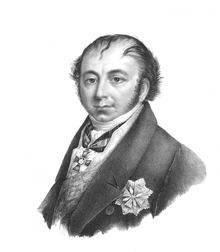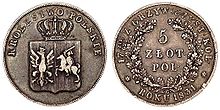- National Bank of Poland
-
National Bank of Poland
Narodowy Bank Polski (Polish)
National Bank of Poland branch building in Wrocław, Poland Headquarters Warsaw Established 1945 President Marek Belka Central bank of Poland Currency złoty ISO 4217 Code PLN Website (Polish) (English) National Bank of Poland official site Preceded by Bank of Poland (1828 and 1918) Narodowy Bank Polski (NBP; the National Bank of Poland) is the central bank of Poland. It controls the issuing of Poland's currency, the złoty. The Bank is headquartered in Warsaw, and has branches in every major Polish town. The NBP represents Poland in the European System of Central Banks, an EU organization.
Following the death of Sławomir Skrzypek in the Polish Air Force Tu-154 crash on 10 April 2010, the Bank's leadership has been vacant.
On 10 June 2010, Marek Belka was approved by the Parliament (253 votes in favor; 184 against) as Head of National Bank of Poland.
Contents
History
5-złoty coin issued during the November 1830 Uprising.
Although the bank has existed under its current name since 1945, it is a continuation of two previous central banks of Poland, both named simply Bank of Poland (Bank Polski). The first one was founded in Warsaw in 1828 by Duke Franciszek Ksawery Drucki-Lubecki. An institution of the government of the Kingdom of Poland, it was entitled with issuance of the Polish currency as well as control over the credit rates. It was also entitled with a concession to operate foreign currencies and buy off credits issued by foreign companies and banks.
Throughout its existence, the Bank of Poland was allowed to issue banknotes and coins up to the amount of its stock (initially 30,000,000 złotych, 42 millions in 1834 and 53 millions in 1841). As a legal entity, the bank also financed a number of important enterprises in Russian-held Poland. Between 1829 and 1837 it spent a large part of its income on road construction, until 1842 it was also the main sponsor of the coal mining development in the region of Zagłębie and the Old Polish Industrial Area around Skarżysko-Kamienna.
Seriously crippled by administrative measures after the November Uprising, after the January Uprising it was made subordinate directly to the Russian Imperial Ministry of Treasury. During the period of liquidation of Polish institutions following the failed uprising, in 1870 it was deprived of the rights of a currency issuing organ and banned from giving long-term credits. On 1 January 1886 it was officially closed down and by 1894 its assets were swallowed by the State Bank of Russia.
When Poland regained independence in 1918, it was lacking a central bank. Pursuant to the State Treasury Repair Act of 11 January 1924, Minister Władysław Grabski created a new Bank of Poland as a joint stock company. Its stock was soon raised from the initial 100,000,000 złotych to 150 million, split into 1.5 million shares. The bank was independent of the government of Poland, though it carried out the government's monetary policies. As the main shareholder, the President of Poland had the right to name the chairman and deputy chairman of the bank's board of trustees.
Until 31 December 1944, the bank had a monopoly for printing currency, with gold reserves of 40% or higher. The dividend could not exceed 8% of income. In the event of a higher income, the state treasury had the right to 50% to 66% of it. Prior to the invasion of Poland in 1939, all the gold reserves were evacuated from Poland to Paris, then to London and on to Canada. The Bank continued to function in exile, as the central bank of the Polish Government in Exile, and financed most of the Polish armed forces. In 1946 the remaining prewar gold reserves were returned to Poland's new communist authorities, while the Bank of Poland itself was closed down and finally in 1952 absorbed by the newly-created National Bank of Poland.
The latter was one of two banks allowed to operate in Poland's postwar planned economy. It had a monopoly for currency, credits and cumulation of savings. The other bank, PKO Bank Polski, was responsible for private accounts. After the fall of the communist system in 1989, the market economy was reintroduced and the NBP limited its functions to currency control and supervision of other, privately-controlled banks.
Structure
The structure and functioning of the National Bank of Poland are regulated by article 227 of the Constitution of Poland of 1997 and the National Bank of Poland Act of the same year[1]. The President of the NBP is appointed by the Sejm, at the request of the President of the Republic of Poland, for a term of six years. The NBP President is responsible for the organisation and functioning of the National Bank. The same person cannot serve as President of the NBP for more than two terms of office. Apart from his function as the superior of the NBP staff, he is also the chairman of the Monetary Policy Council, the NBP Management Board and the Commission for Banking Supervision. He is also responsible for representing Poland in international banking and financial institutions.
List of Presidents of the NBP
- Edward Drożniak (1945-1949)
- Witold Trąmpczyński (1950-1956)
- Edward Drożniak (1956-1961)
- Adam Żebrowski (1961-1965)
- Stanisław Majewski (1965-1968)
- Leonard Siemiątkowski (1968-1972)
- Witold Bień (1973-1980)
- Stanisław Majewski (1981-1985)
- (acting) Zdzisław Pakuła (1985)
- Władysław Baka (1985-1988)
- Zdzisław Pakuła (1988-1989)
- Władysław Baka (1989-1991)
- Grzegorz Wójtowicz (1991)
- (acting) Andrzej Topiński (1991-1992)
- Hanna Gronkiewicz-Waltz (1992-2001)
- Leszek Balcerowicz (2001-2007)
- Sławomir Skrzypek (2007-2010)
- (acting) Piotr Wiesiołek (2010)
- Marek Belka (since 2010)
Buildings
See also
References
- ^ (Polish) Ustawa o Narodowym Banku Polskim, 29 August 1997
External links
Central banks of the European Union 
Within Eurozone National Bank of Austria · National Bank of Belgium · Central Bank of Cyprus · Bank of Estonia · Bank of Finland · Banque de France · Deutsche Bundesbank · Bank of Greece · Central Bank and Financial Services Authority of Ireland · Banca d'Italia · Central Bank of Luxembourg · Central Bank of Malta · De Nederlandsche Bank · Bank of Portugal · National Bank of Slovakia · Bank of Slovenia · Bank of SpainOutside Eurozone Banking-related
EU institutions Central banks ·
Central banks ·  European Union
European UnionMembers of Euro Banking Association Austria Allgemeine Sparkasse Oberösterreich · Bank für Tirol und Vorarlberg AG · BKS Bank AG · Erste Group Bank AG · Oberbank AG · Oesterreichische Nationalbank · Raiffeisen Zentralbank Österreich AG · Raiffeisenlandesbank Oberösterreich AG · Raiffeisen-Landesbank Tirol Aktiengesellschaft · Steiermärkische Bank und Sparkassen AGBelgium Cyprus Denmark Amagerbanken A/S · Arbejdernes Landsbank A/S · Danske Andelskassers Bank A/S · Danske Bank A/S · DiBa Bank A/S · Djurslands Bank A/S · Jyske Bank A/S · Nordjyske Bank A/S · Nørresundby Bank · Østjydsk Bank A/S · Ringkjøbing Landbobank · Roskilde Bank A/S · Skjern Bank · Spar Nord Bank · Sparekassen Sjælland · Sydbank A/S · Vestfyns Bank A/S · Vestjysk BankFinland Aktia Bank PLC · Bank of Åland PLC · Nordea Bank Finland PLC · Pohjola Bank PLC · S-Bank LTD. · Tapiola Bank LTDFrance Banque Michel Inchauspé - BAMI · Banque Palatine · BNP Paribas SA · BPCE · BRED Banque Populaire · Crédit Agricole SA · Crédit Coopératif · Crédit du Nord · Crédit Mutuel Arkéa · Credit Mutuel CIC Banque · HSBC France · La Banque Postale · Natixis · Société GénéraleGermany Berenberg Bank · BHF Bank · Bremer Landesbank · Commerzbank AG · Deutsche Bank AG · Deutsche Bundesbank · Deutsche Postbank · DZ Bank AG · Europe Arab Bank Frankfurt · Hamburger Sparkasse AG · J.P. Morgan Chase Bank AG · Landesbank Baden-Württemberg · Landesbank Berlin Holding · Landesbank Hessen-Thüringen · Oldenburgische Landesbank · SECB Swiss EURO CLEARING Bank GmbH · The Bank of New York Mellon, Frankfurt Branch · VTB Bank (Deutschland) AG · WestLB AGGreece Hungary Ireland Italy Banca Agricola Popolare di Ragusa · Banca del Fucino · Banca del Piemonte · Banca delle Marche S.p.A. · Banca di Imola S.p.A. · Banca di Romagna S.p.A. · Banca d'Italia · Monte dei Paschi di Siena · Banca Monte Parma · Banca Nazionale del Lavoro · Banca Popolare del Lazio · Banca Popolare dell'Emilia Romagna · Banca Popolare di Milano · Banca Popolare di Sondrio · Banca Popolare di Spoleto · Banca Popolare di Vicenza · Banca Sella · Bancaperta S.p.A. · Banco Popolare Società Cooperativa · Cassa di Risparmio della Provincia di Chieti S.p.A. · Cassa di Risparmio della Provincia di Teramo S.p.A. · Cassa di Risparmio di Cesena S.p.A. · Cassa di Risparmio di Fermo S.p.A. · Cassa di Risparmio di Ferrara S.p.A. · Cassa di Risparmio di Loreto S.p.A. · Cassa di Risparmio di Ravenna S.p.A. · Credito Emiliano S.p.A. · ICCREA Banca · Intesa Sanpaolo · Istituto Centrale delle Banche Popolari Italiane · Raiffeisen Landesbank Südtirol – Cassa Centrale Raiffeisen dell'Alto Adige · Südtiroler Volksbank – Banca Popolare dell'Alto Adige · UBI Banca · UGF Banca · UniCredit · Veneto BancaLuxembourg Banque et Caisse d'Épargne de l'État · Banque Raiffeisen · Dexia Banque Internationale à Luxembourg SA · KBL European Private Bankers S.A. · Société Générale Bank & TrustNetherlands Poland Bank BPH SA · Narodowy Bank PolskiPortugal Banco BPI SA · Banco Comercial Português · Banco Espírito Santo · Caixa Central de Crédito Agrícola Mutuo · Caixa Geral de DepósitosSlovenia Spain Banco Bilbao Vizcaya Argentaria SA · Banco Cooperativo Español SA · Banco Sabadell · Banco Español de Credito · Banco Pastor SA · Banco Popular Español SA · Banco Santander, SA · Bankinter SA · Bilbao Bizkaia Kutxa · Caixa de Aforros de Galicia, Vigo, Ourense e Pontevedra (NovaCaixaGalicia) · Caixa d'Estalvis de Catalunya, Tarragona i Manresa · Caixa d'Estalvis i Pensions de Barcelona (La Caixa) · Caja de Ahorros del Mediterráneo · Caja Gipuzkoa San Sebastian · Caja Laboral Popular Coop. de Credito · Caja Madrid · Confederacion Española de Cajas de Ahorros · Ipar Kutxa RuralSweden United Kingdom Bank of America NA · Bank of Tokyo-Mitsubishi UFJ Ltd. · Barclays Bank PLC · Citibank NA · HSBC Bank PLC · Kookmin Bank International Ltd. · Lloyds TSB Bank PLC · National Australia Bank Limited · National Westminster Bank PLC · Royal Bank of Scotland PLC · Standard Chartered Bank · UBS AG · Wells Fargo Bank NANon-EU Coordinates: 52°14′11″N 21°00′53″E / 52.23639°N 21.01472°E
Categories:- Banks of Poland
- European System of Central Banks
- Central banks
Wikimedia Foundation. 2010.






